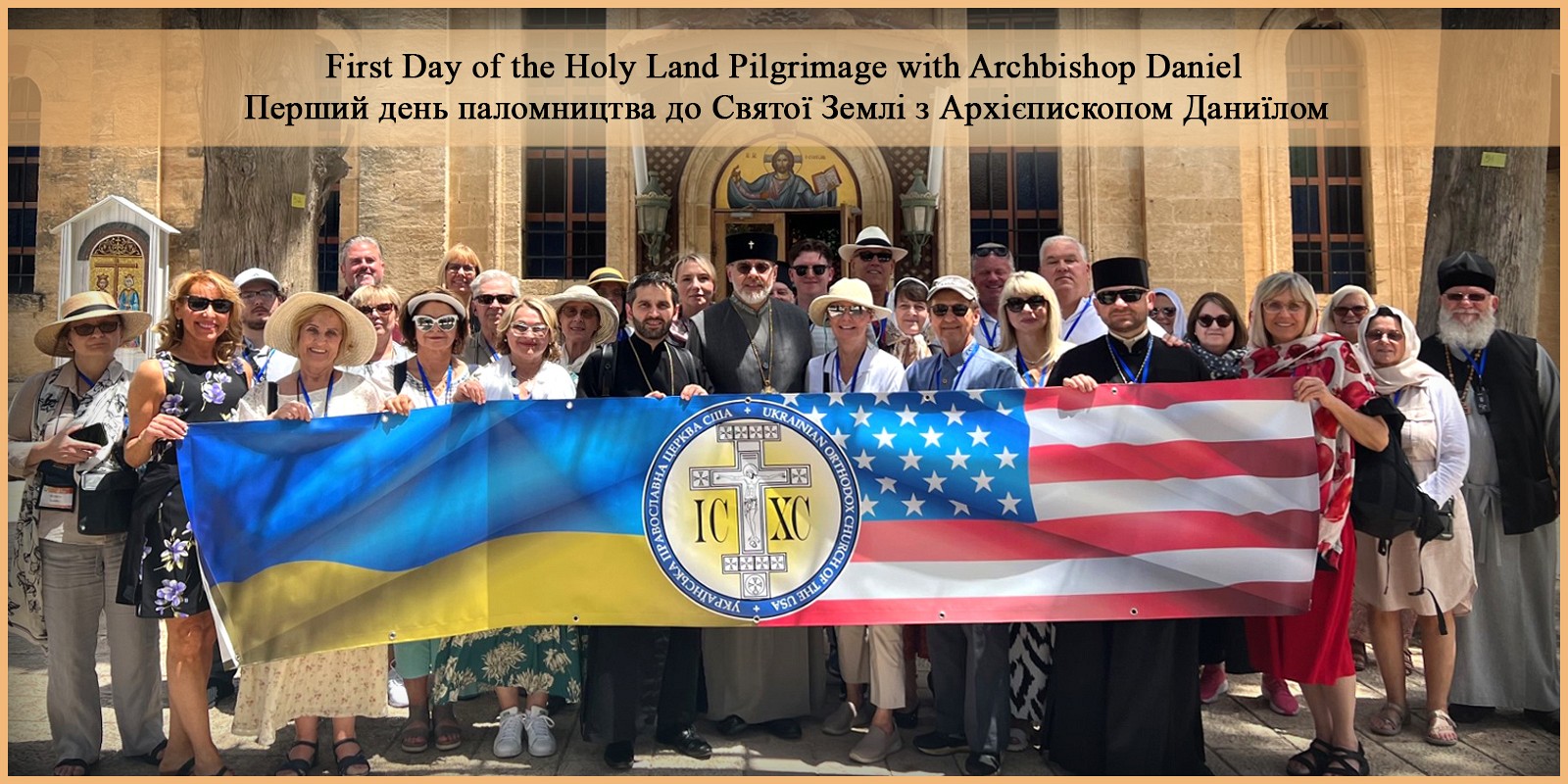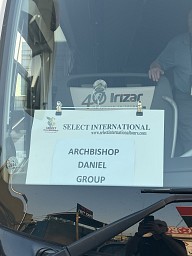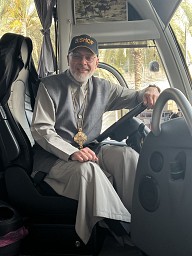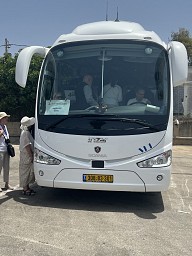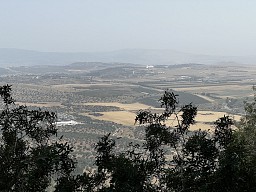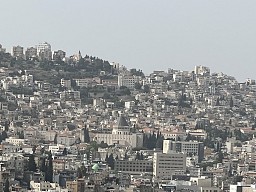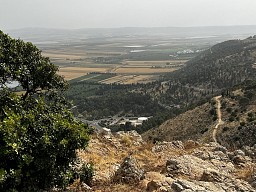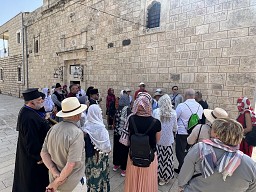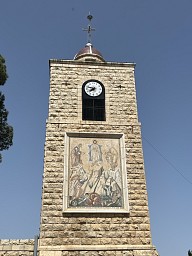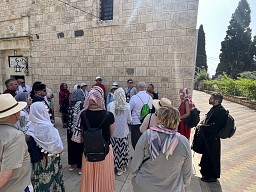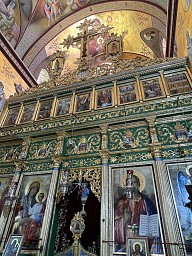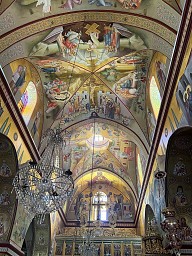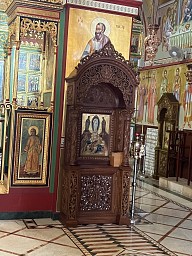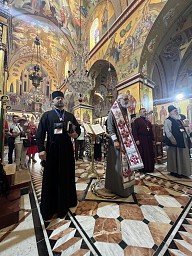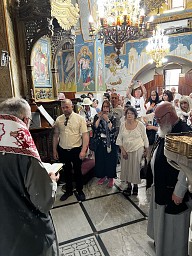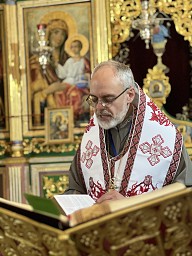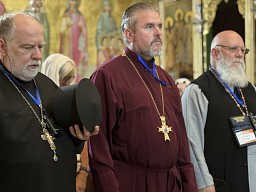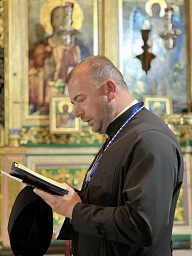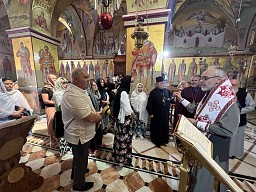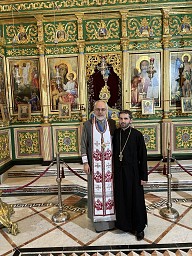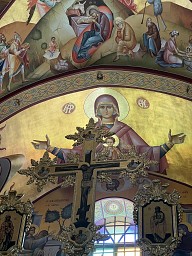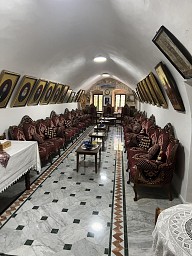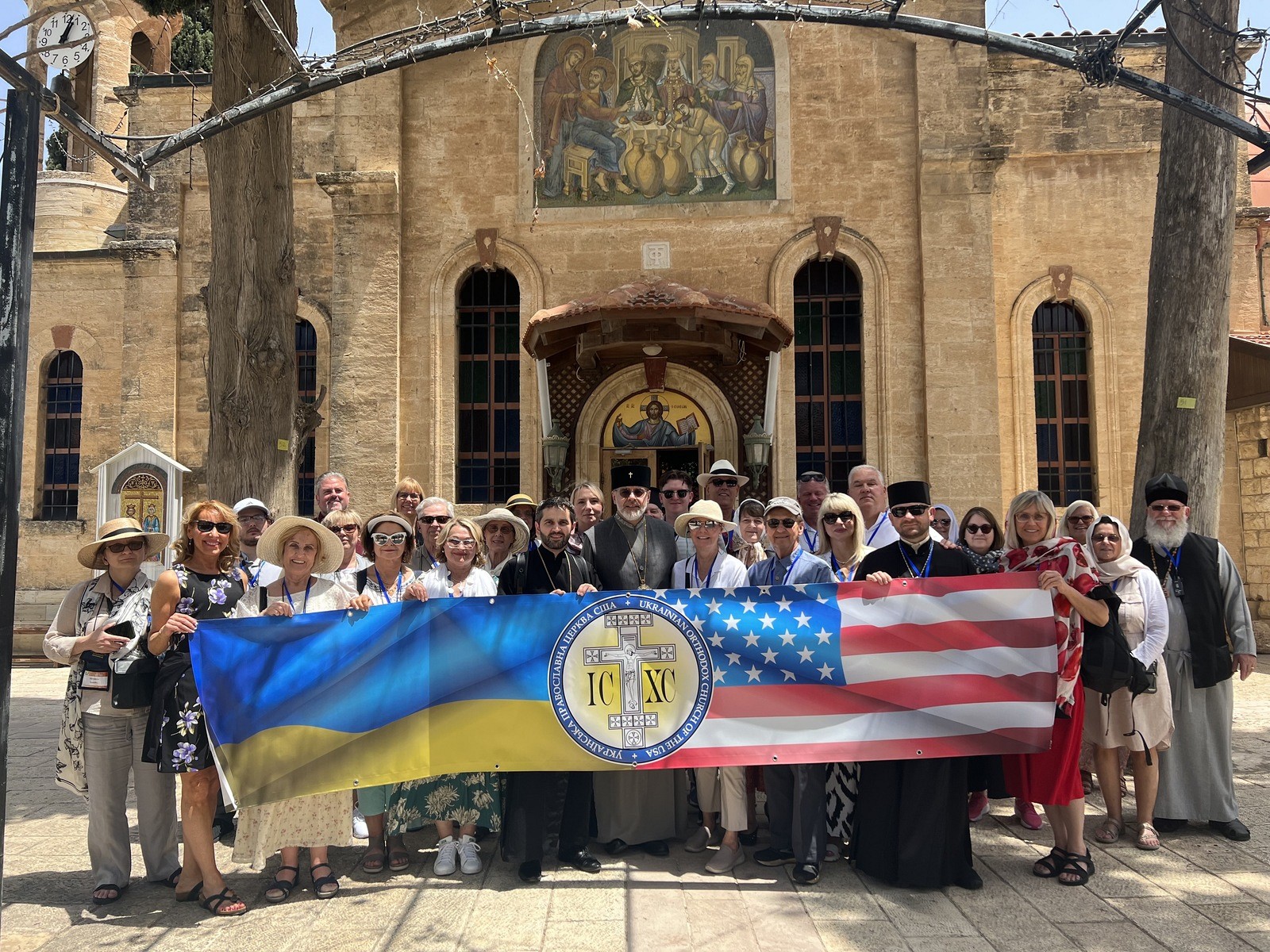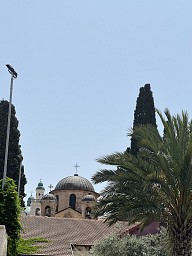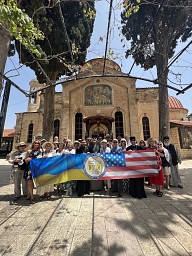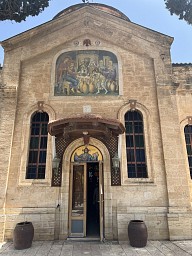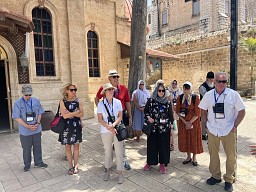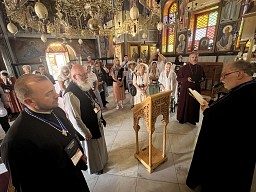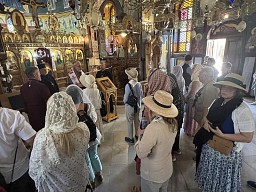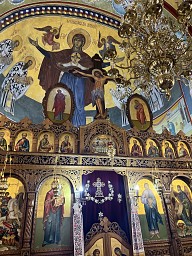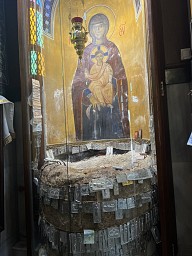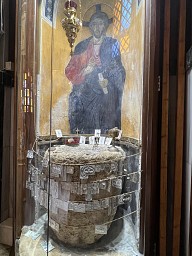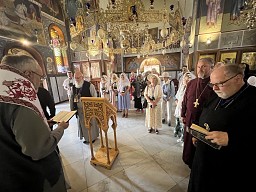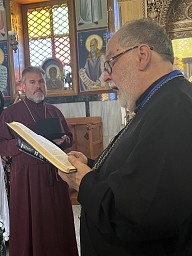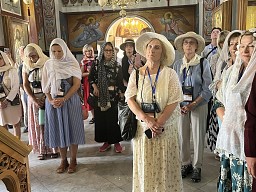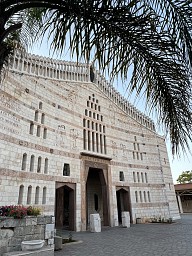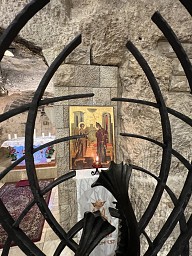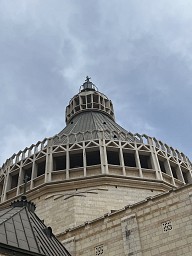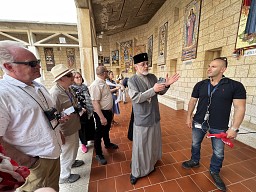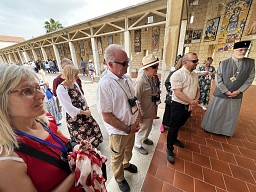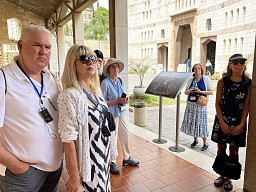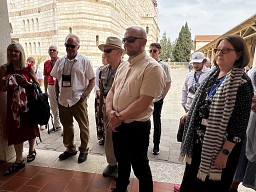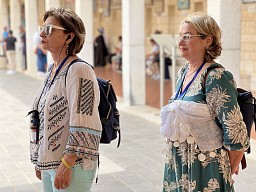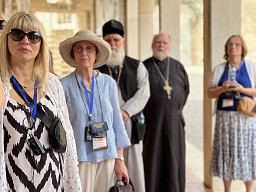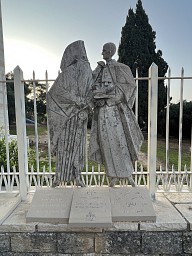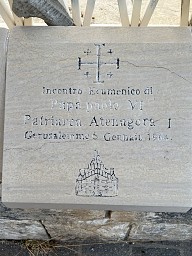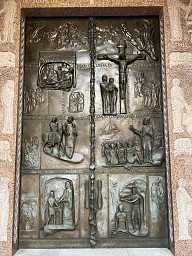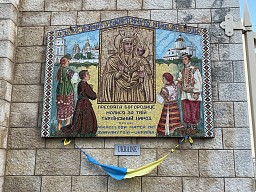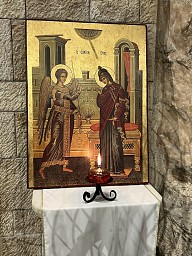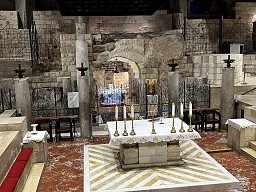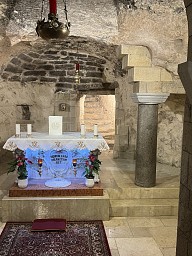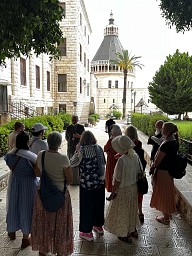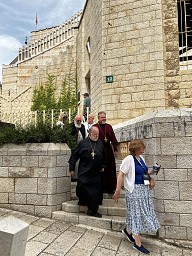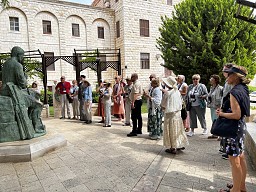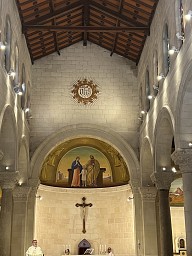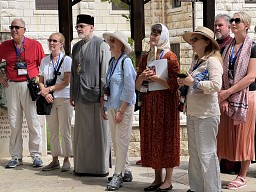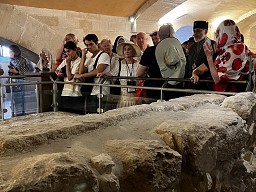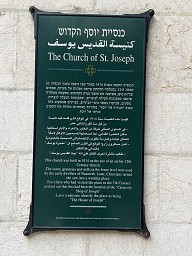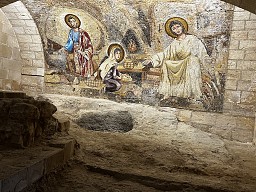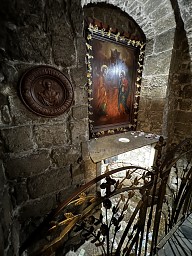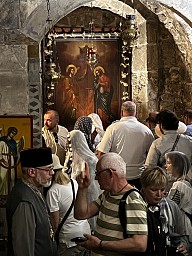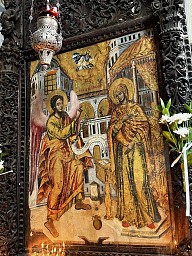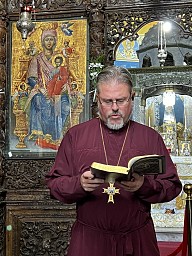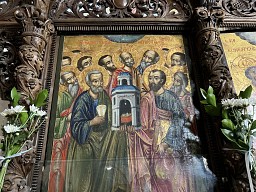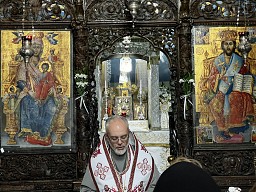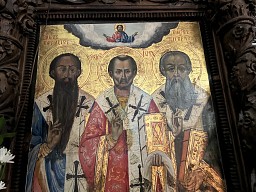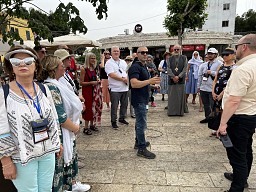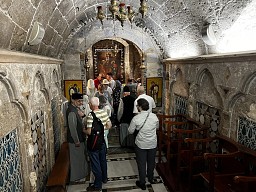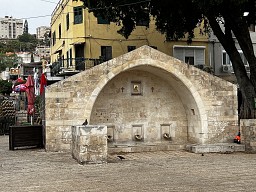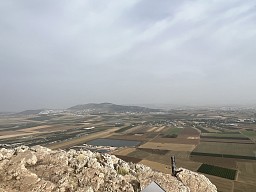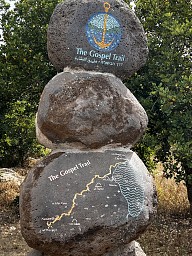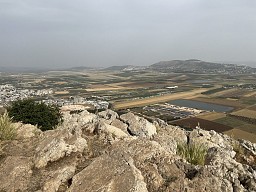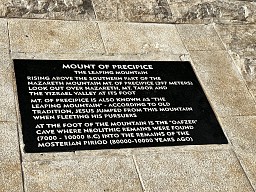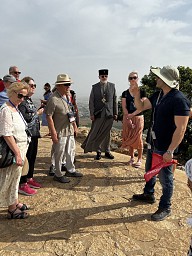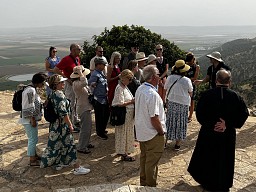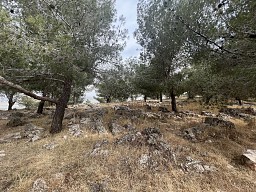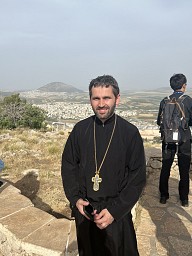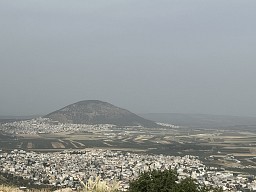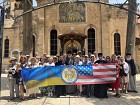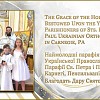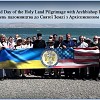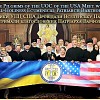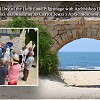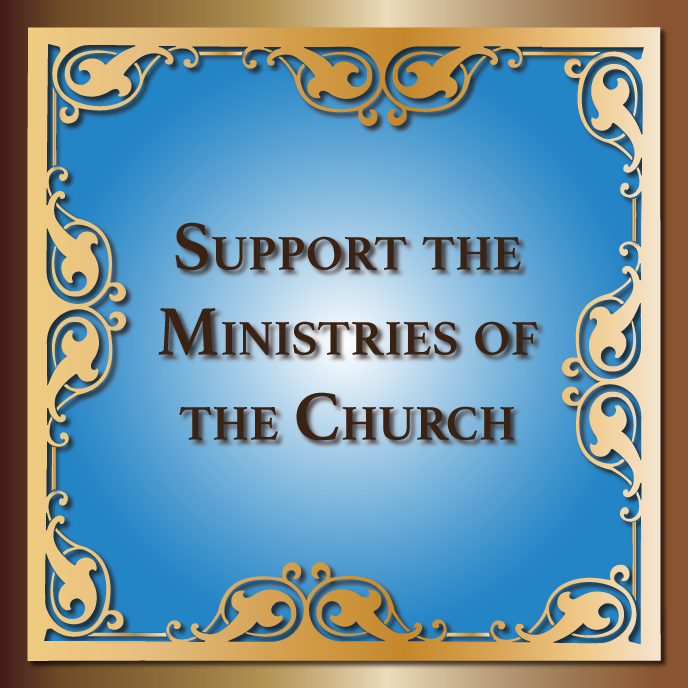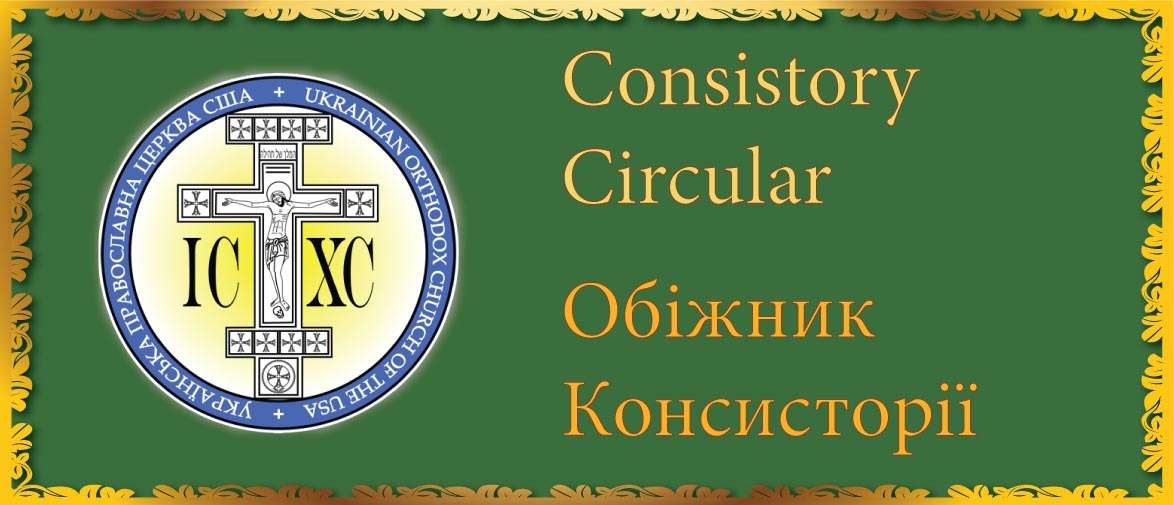Паломники УПЦ США Розпочали Паломництво Святою Землею
After a long flight across the Atlantic, the group of 33 pilgrims, led by His Eminence Archbishop Daniel, spiritual father of the Western Eparchy and Consistory President of the Ukrainian Orthodox Church of the USA arrived in Tel Aviv, Israel, and embarked on their journey to the sacred sites in the Holy Land.
Having boarded the Select International Pilgrimage Tours bus, they got comfortable for the drive to Nazareth where they would spend their first night. 33 pilgrims hailing from all corners of the United States, comprised of clergy, their wives, parishioners, and those who seek a closer relationship with God, all got to know each other. As their tour guide Elias, introduced himself, he immediately got busy pointing out various sites from a distance as they drove by.
Everyone stopped rifling through their bags, and chitchatting with their seatmates as he pointed out a small outcropping in the distance. Mount Megiddo, the hill overlooking a valley, is identified as the site of the final battle between the forces of good and evil at the end of time, known as Armageddon and mentioned in the New Testament in Revelation 16:16. The reality of where they were suddenly became very real to everyone.
As the continued to travel, signs appeared pointing to Nazareth, the location where Christ spent His youth. Bougainvillea grew rampant along the byways, and the bright red, pink, and white blossoms swayed in the light breeze as the bus made a final turn and neared the city. The vast open dry land to the left and right of the bus were arid, with meager shrugs, and prickly plants dotting the landscape. However, the distance, the flat landscape was punctuated by one rather large round mountain. Noticing everyone’s gaze, the tour guide smiled and informed them that what they were seeing was Mount Tabor, where the Lord was Transfigured before His three beloved Apostles – John, James and Peter, standing between Moses and St. Elijah, gowned in bright glory, to the awe of the Disciples. Everyone gazed thoughtfully as they gazed upon the round mountain in the distance, imagining the Lord Himself at the pinnacle.
Before arriving at the designated hotel, the bus parked in Nazareth, where the passengers disembarked and went for a leisurely walk through the city. The sun was low on the horizon, and a cool breeze blew down the alleys and byways as the group walked over cobbled streets illuminated by countless strings of lights bobbing in the wind, and enjoyed window shopping at the local shops. They paused at the locked gates of the large Church of the Annunciation, which they would visit tomorrow, before returning to the bus and heading to their hotel.
The bus bounced and made a final turn before speeding through a short tunnel and arriving at the hotel. Retrieving their luggage, the pilgrims registered, found their rooms, and then made their way down to enjoy their first communal meal.
Archbishop Daniel led everyone in prayer, and as everyone sat down, he thanked them for joining him on this pilgrimage, stating that this would be a life changing couple of weeks. They would be visiting the most holy places on Earth, and while God is present everywhere, He chose these lands upon which to Incarnate, to fulfill His earthly mission, to ensure the salvation of mankind, and from which to Ascend to sit at the Right Hand of the Father. It is a blessing to walk upon this land, to venerate these holy relics, and to come closer to God through this experience. His Eminence asked that those present not be tourists but be true pilgrims. That this journey not be a sightseeing expedition, but a soul searching journey. He asked that everyone pause at each site and absorb everything before them, not only with their eyes, but, with the hearts and souls, and take these moments, hidden in their hearts, back with them, and relive them daily. When they read or listen to the Gospel Readings, they will now have a better understanding of the circumstances and the reasons why things happened the way they did. Life will have a deeper meaning from this moment forward and they will be forever changed.
With his final blessing, everyone settled down to enjoy a delicious meal of local cuisine. After a number of courses and visits to the buffet, some of the team members bid goodnight and retreated to their rooms to unpack, while others lingered over coffee, getting to know their teammates. People introduced themselves, which parishes they were from, shared stories about their families, and made plans for the week ahead. The evening passed in pleasant conversation and camaraderie, but soon eyes got heavy, and the long flight and time-change took its toll. With final goodnights and smiles, the pilgrims made their ways to their awaiting beds. With their first Evening Prayers recited in the Holy Land, everyone laid down and quickly drifted off to slumber, lost in dreams of holy places and experiences which awaited them.
The pilgrims regrouped by the monastery gate, as Archbishop did a headcount to ensure nobody was lost. Knocking on the large and impressive iron gate, they waited a moment before one of the nuns peered through the little spy window and recognizing His Eminence, swung the door wide open with a smile, asking his blessing and gesturing for everyone to enter. Stepping carefully, the pilgrims entered the monastery grounds and ascended the steps leading to the courtyard. In addition to the monastics, the pilgrims were greeted by the monastery cats who purred a warm welcome.
Before them loomed a beautiful large stone church. As the women covered their heads, the group walked towards the open and welcoming door to the church. Crossing themselves the faithful entered and were immediately awed. Before them heaven was revealed, as it was to the Apostles during the Transfiguration of the Lord. All the walls of the church were covered in iconography. From the left the halos of the Apostles, Saints, and Church Fathers glowed warmly as their eyes followed them in. The left walls were covered with large murals of female saints whose loving gazes and soft smiles encouraged the pilgrims. The walls were lined with ancient wooden benches. Everyone gathered in the center, awed by the beauty surrounding them, gazed upwards and craned their necks to appreciate all the images floating ethereally above them – God, watching from above.
Donning his Epitrachelion and Omophorion, Archbishop Daniel entered the altar and brought out the Gospel Book placing it on the tetrapod. As the group gathered, he read the day’s reading in English language, while Very Rev. Fr. Mykola Andrushkiv chanted in Ukrainian language, his voice echoing around the pillars and amidst the pilgrims and the saints surrounding them. Closing the Gospel, he presented it to everyone to venerate before returning it to the Altar. The Moleben service continued for the clergy and faithful of the Ukrainian Orthodox Church of the USA, but especially for the end of the war in Ukraine. Vladyka Daniel mentioned by name several wounded soldiers who are in need of our prayers and support.
The group split up as everyone wandered around the beautiful church, praying in corners, gazing upon the faces of the saints which were illuminated by the sun pouring in from the windows above.
The monastics invited them to a side room for chai and freshly baked bread. The pilgrims paused at their counter in the side room and asked to see various items they had for sale. Pretty crosses, woven bracelets, prayer ropes, lapel pins, and small icons. Having purchased a few items, and left a donation along with a list of names for prayerful commemoration during church services, the pilgrims piled out and walked strolled around the monastery complex, enjoying the beautiful and serene gardens, pausing here and there to absorb the fact that they were standing upon Mount Tabor, before bidding a fond farewell to the nuns, making their way back out through the large iron gate to await the return of the vans in the outer courtyard.
The vans arrived in a flurry of activity as the group clambered aboard and the vans zipped back down the mountainside. Soon the pilgrims were once again in their own bus as it traveled across the arid and hilly vista on its way to Galilee. As the occupants chatted and gazed out the windows, the bus entered an urban area and soon drew to a stop along a tree lined street. Disembarking, the pilgrims went uphill along an alleyway, and soon found themselves entering under a wrought iron arch into a lovely courtyard. A fountain happily gurgled in a corner as the bright fuchsia bougainvillea and pink rose bushes swayed in the hot breeze.
On the right stood a small shop which the pilgrims walked past as they entered deeper into the courtyard. In the middle stood a small domed chapel, which they paused at before continuing to the tall cedars which bordered a trellis covered path which led to the entrance of the Cana of Galilee Greek Orthodox Church. The limestone edifice glowed warmly in the sunshine, as a multitude of birds chirped and sang in the thick green trees. Above the main door was a large mosaic of the Wedding in Cana of Galilee, depicting the Mother of God imploring Christ to help the parents of the newlyweds who had run out of wine at the wedding banquet of their children.
Before entering, the group paused in the shade to take a group photo, unfurling, and holding the banner they brought from home with the flags of both Ukraine and the United States. Having taken the photo, everyone crossed themselves and entered the dimply lit church. Once again, their eyes and souls overflowed with the beauty greeting them. The iconography surrounding them depicted every pivotal moment of Christ’s earthly life, His many miracles, healings, and teachings. Candles flickered in their candleholders, reflecting upon the glass windows which encased two objects on either side of the Nave.
Looking closer, the pilgrims were astounded to find that the glass protected two large stone jugs. The jugs were ancient and were designed to hold wine. The tour guide explained that we often are shown ceramic jugs in icons and images, but ceramic would not have been used to hold wine, as the minerals within the ceramic clay would have reacted with the acidity of the wine poured into them. In fact, the jugs that were used for wine were made of stone. These two large urns, which now held folded papers of prayers and requests, gold crosses, chains and other trinkets pilgrims managed to slip between the panes of glass, once held the water which the Lord changed into wine. In awe the pilgrims took turns gazing upon them and in their minds going back in time, over 2,000 years back and being present at the wedding where Christ performed His very first public miracle at the bequest of His Holy Mother.
Once again Archbishop Daniel gathered everyone together for prayer, after which they all had time to wonder about the church to pray, venerate the sacred objects, and light candles. Protopresbyter Stephen Hutnick chanted the Gospel narrative in English language, while the archbishop proclaimed the Word of God in Ukrainian language. Many purchased silver amulets, each with a particular purpose – if one had mobility issues, there was a silver amulet in the shape of a leg; babies for those who wished to conceive; heads for those who suffered from headaches, etc. Taking those amulets, many of the pilgrims stood and prayed for the Lord’s mercy, and then hung them up in the church to hold and send their prayers to the Lord during the upcoming church services.
Before returning to the bus, the pilgrims had an opportunity to purchase some wine made locally in Cana to enjoy in the cool shade of the courtyard, and to take home with them to share with family and friends. As they walked down the streets, they stopped at several shops selling church goods, icons, crosses, as well as souvenirs.
Back on the bus, the pilgrims stashed their purchases in overhead compartments, and rested a little from the heat of the day, before the bus once again returned to Nazareth and the doors opened. The little group disembarked and made their way along the streets they had walked the evening before and arrived at the now open gates of the Roman Catholic Church of the Annunciation.
The towering cupola of the Church of the Annunciation stands over the cave that tradition holds to be the home of the Virgin Mary. Here, it is believed, the Archangel Gabriel asked her if she would be willing to become the mother of the Son of God. And here the young Mary uttered her consent: “Let it be done to me according to your word.”
The outcome of Mary’s consent is carved in Latin across the façade over the triple-doorway entrance: “The Word was made flesh and dwelt among us” (John 1:14). The massive two-story basilica is surrounded by a large courtyard. Upon entering the courtyard, immediately to their left the group noticed something familiar. An icon from Ukraine, depicting individuals dressed in Ukrainian costumes. The entire courtyard was surrounded by tall walls covered with icons and images of the Mother of God, sent from all the nations of the world. The group wandered around and were amazed at the wide variety of images, each different and uniquely representing the lands and peoples who created them, clearly representing their nation’s styles and colors.
Entering through the massive doors of the basilica the faithful had to pause to allow their eyes to adjust to the dark environment. The cavernous church, built in a modern, open style, invited those who entered to walk the circumference of the building. As the group made their way around, they went down a few steps and found themselves before a gate through which they could see a grotto that contained the traditional cave-home of the Virgin Mary. Before the cave stood a simple altar, flanked by ruins of two ancient churches which had first been built around 427 AD.
As the group moved on they looked up at the cupola which was designed to represent a lily, which was to symbolize the purity of the Virgin Mary, the Lily given to her by Archangel Gabriel, and the name of Nazareth – “flower”. Ascending the stairs, they pilgrims found themselves in the Roman Catholic church used by the local community, its many pews lining the wide nave.
Back in the courtyard, they could see excavations beneath the large church, described in 2009 by the Israel Antiquities Authority as the “very first” residential building found from the old Jewish village.
Exiting the courtyard, and squinting against the bright sun, the team made their way along the streets of Nazareth, arriving at the Church of St. Joseph. A fond tradition asserts that this church is built over the carpentry workshop of Joseph the Betrothed. The church stands in the shadow of the soaring cupola of the Church of the Annunciation from which they had just come, on its southern side — just as St. Joseph himself lived in the shadow of Christ and the Ever-Virgin Mary.
The church was built in 1914 over an old Crusader Church, which was built over a system of caves. Inside the church everyone paused to appreciate the image of an elderly Joseph dying, flanked by Christ on one side, and the Birth-giver of God on his other side.
As the sun moved towards the western horizon, the pilgrims made their way to the Greek Orthodox Church of the Annunciation. Walking into the wide courtyard the faithful once again were greeted by two icons on a wall of the courtyard with Ukrainian symbols upon them. Pausing to cross themselves before these icons from Ukraine and praying for Ukraine’s independence and safety of her people, the pilgrims turned towards the door of the church. Holding on to the columns the faithful descended the steps leading to the door and entered the ancient church. To their right stood the massive and power iconostas, its dark wood revealing the great age of the structure. Crossing themselves once again they bowed before the Altar, before proceeding to the other side of the church where they descended more steps which led them down to a grotto.
In the tiny room they could hear the loud gurgling of water. Below the large icon of the Annunciation, they could look down through the rocks to the fresh stream of water that still flowed in the well. This is the well from with the young Virgin Mary had come often to fill containers with water. During one such instance, the Archangel Gabriel appeared to her. She was frightened, and unbelieving of the site before her and quickly returned to her home, where the angel once again appeared to her, and told her to fear not.
Once again, Archbishop Daniel put on his Epitrachelion and Omophorion and read the Gospel from Luke 1:26-38 in Ukrainian language, while Very Rev. Fr. Harry Linsinbigler chanted the Gospel reading in English language. The faithful bowed their heads and listened how Archangel Gabriel explained to the Virgin Mary that the Lord was with her and asked if she would be willing to become the Mother of God. As His Eminence’s voice echoed in the grotto and up into the church above, the clear, cool water of the well continuously gurgled as if accentuating his words.
Having prayed and venerated the icon of the Annunciation, the faithful took turns at the spigot in the wall of the grotto, collecting some of the water from Mary’s Well into little bottles to take home with them.
Deep in thought, and still in awe at the reality of all they’d seen and heard this day, the team once again found themselves on the bus traveling through the streets of the quiet city. Their final stop of the day was at Mount Precipice, just on the outskirts of Nazareth. The site is located on the cliffs of Mount Kedumim, overlooking the Jezreel Valley.
After his baptism, Jesus returns to Nazareth and at the local synagogue declares, for the first time in public, that He is the Messiah. Rejecting His claim, the Nazarenes declare Him a false Messiah, and drag Him to the “edge of the city“. They attempt to throw Him to His death off the cliff, but “he passed through the midst of them and walked away” (Luke 4:29-30).
Since the Byzantine period its summit is identified with the site where Christ was almost executed. On its western side are remains of a Byzantine period monastery which commemorated the event.
Walking up the curving path to the summit, the faithful found themselves once again in a lovely courtyard, in the center of which grew a lush green olive tree. Before them opened the wide expanse of the Jezreel Valley. Below them the outcropping quickly disintegrated to rough stones and boulders. Looking down it was clear that if anyone fell or was pushed over, they would suffer great bodily harm, if not death. Behind them the hillside was covered with homes of the local Nazarenes. It was easy to imagine a young Jesus playing on this very hill with his friends and neighbors as a child.
The tour guide brought their attention to Mount Tabor which rose in the distance to their left. The landscape was flat and arid, with Mount Tabor clearly silhouetted against the barren landscape. It is for this reason that the slightly rounded mountain is also known as the “Belly Button” of the world.
Just to the right of Mount Tabor, shimmering in the haze like a mirage the people could barely make out a small town. This was Nain, where Christ when entering the city with His Disciples, encountered the funeral procession of a widow’s only son exiting the city. This was where life and death met. This was where Christ took pity upon the weeping woman, realizing that by the death of her only son, the widow would now have a very difficult life. In those days women were not permitted to walk the streets, shop, etc. without a male relative, husband, or son to accompany them. Without her asking, the Lord took pity upon her, told her not to cry, stopped the procession, touched the bier and instructed, “Young man, I say to you, rise!” (Luke 9:14). The dead man sat up and began to speak, and the Lord returned the widow’s son to her and returned not only the life of the son, but of his mother as well.
Pondering all this the pilgrims were amazed, awed, and speechless as their hearts and souls tried to comprehend all that they were witnessing this day. Quietly, and with a final furtive look back over their shoulders, they slowly returned to their awaiting bus. The cool air of the bus lulled many to sleep, while others scribbled in their notepads, eager to write down their emotions and feelings.
Soon they arrived at the hotel with enough time to refresh themselves before dinner. Tonight, their prayers would be more heartfelt than ever, and their sleep would be deeper and more restful than ever.
Tomorrow their journey would continue, but, tonight, they would rest.
|
| |||||||||||||
